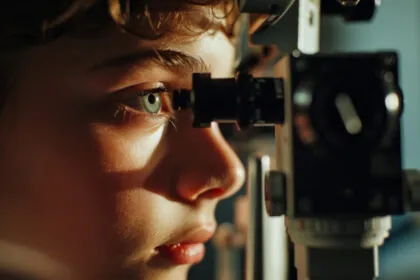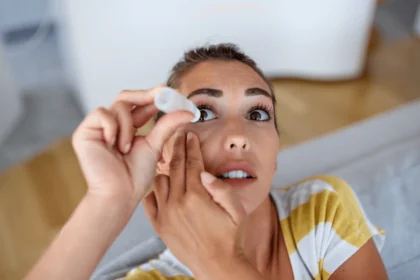Glaucoma refers to a group of eye conditions that cause damage to the optic nerve, which is responsible for transmitting visual information from the eye to the brain.
The main characteristic of glaucoma is increased pressure within the eye, known as intraocular pressure (IOP).
This increase in pressure can damage the optic nerve over time and potentially lead to vision loss or blindness.
There are different types of glaucoma, with primary open-angle glaucoma being the most common form.
In this type, the drainage channels within the eye become less efficient at fluid drainage, leading to a buildup of fluid and an elevation in IOP.
Other types include angle-closure glaucoma, congenital glaucoma (present at birth), and secondary glaucoma (resulting from other eye conditions or medical conditions).
Glaucoma is often referred to as the “silent thief of sight” because it typically progresses slowly and painlessly, with no noticeable symptoms in the early stages.
As the condition advances, peripheral vision may gradually be affected, leading to a condition known as tunnel vision.
Without timely intervention and treatment, glaucoma can eventually cause irreversible vision loss.
The Risk
The risk of glaucoma can vary depending on several factors, but certain groups of individuals are generally considered to be at a higher risk.
Here are some key factors that can increase the likelihood of developing glaucoma:
Age
The elderly population is indeed more at risk of developing glaucoma compared to younger individuals. There are several reasons for this increased vulnerability:
- Age-related changes:
As we age, there are natural changes that occur in the eyes.
These changes can lead to an increased risk of glaucoma. For instance, the drainage angle in the eye may become less efficient over time, which can result in the buildup of fluid and increased eye pressure, a key risk factor for glaucoma. - Increased intraocular pressure:
Older individuals may experience an elevation in intraocular pressure (IOP), which is a major risk factor for glaucoma.
This can be attributed to reduced fluid drainage or increased fluid production.
With age, the ability of the eyes to maintain optimal IOP may decline, contributing to a higher risk of glaucoma. - Gradual vision loss:
Glaucoma often progresses slowly and may not cause noticeable symptoms in its early stages.
In many cases, the damage to the optic nerve caused by glaucoma is gradual and painless.
This can make it challenging for older individuals to recognize the problem early on, resulting in delayed diagnosis and treatment. - Other eye conditions
Aging also increases the likelihood of developing other eye conditions, such as cataracts, which may affect vision and increase the risk of glaucoma.
Eye conditions like cataracts can make it more difficult to detect the onset of glaucoma or to accurately measure intraocular pressure. - Comorbidities and medication use:
Older adults may have other comorbidities, such as diabetes or cardiovascular diseases, which can impact eye health.
Additionally, certain medications commonly used by this population, such as corticosteroids, can increase the risk of glaucoma or worsen the disease if already present.
Family History
Family history plays a significant role in the development of glaucoma, a group of eye conditions that can damage the optic nerve and lead to vision loss.
Here’s an explanation of how family history increases the risk of glaucoma:
- Genetic Factors:
Glaucoma can be influenced by genetic factors.
Specific gene variations or mutations may contribute to an individual’s susceptibility to developing the condition.
When there is a family history of glaucoma, it suggests a higher likelihood of inheriting these genetic predispositions. - Familial Forms of Glaucoma:
Some forms of glaucoma have been identified as having a stronger genetic component.
For example, primary open-angle glaucoma (POAG), the most common type of glaucoma, is known to have a hereditary component.
Studies have identified several genetic loci associated with POAG, and having affected relatives significantly increases the risk of developing the condition. - Shared Environmental Factors:
In addition to genetic factors, families often share common environmental and lifestyle factors.
These may include things like diet, exercise habits, eye care practices, and exposure to certain environmental toxins.
These shared factors within families could contribute to the increased risk of glaucoma. - Screening and Awareness:
A family history of glaucoma highlights the importance of regular eye screenings and examinations for individuals with affected relatives.
Those with a family history of glaucoma may be advised to undergo more frequent and comprehensive eye exams to monitor their eye health and detect any signs of glaucoma at an earlier stage.
It’s crucial to note that while having a family history of glaucoma increases the risk, it does not guarantee that an individual will develop the condition.
Conversely, individuals without a family history may still develop glaucoma due to other risk factors such as age, elevated intraocular pressure, or certain medical conditions.
Ethnicity
Ethnicity is a known risk factor for various eye conditions, including glaucoma.
The reason for the increased risk of glaucoma among certain ethnicities is not entirely clear, but it likely involves a combination of genetic and environmental factors.
Here are some factors that contribute to the increased risk of glaucoma in certain ethnic groups:
- Genetic Predisposition:
Genetic factors play a significant role in the development of glaucoma.
Certain ethnic groups may have a higher prevalence of specific genetic variations that increase their susceptibility to the disease.
For example, primary open-angle glaucoma (POAG), the most common type of glaucoma, is more prevalent in people of African, Hispanic/Latino, and Asian descent. - Anatomical Differences:
Some ethnic groups may have anatomical differences that affect the drainage system of the eye, leading to increased intraocular pressure (IOP) and a higher risk of glaucoma.
For instance, narrow angles, where the drainage canals are more likely to get blocked, are more common in people of Asian descent, putting them at a higher risk of angle-closure glaucoma. - Age Distribution:
Certain ethnic groups have a higher prevalence of glaucoma in older individuals compared to other ethnicities.
For example, African Americans have a higher risk of developing glaucoma at an earlier age than Caucasians.
This highlights the importance of regular eye exams and early detection in specific populations. - Healthcare Disparities:
Socioeconomic and healthcare disparities may also contribute to the increased risk of glaucoma among certain ethnic groups.
Limited access to eye care, lack of awareness of the condition, and delayed diagnosis and treatment can impact the management of glaucoma and lead to a higher risk of vision loss.
High Intraocular Pressure (IOP)
High intraocular pressure (IOP) is a significant risk factor for developing glaucoma, a group of eye conditions that can lead to vision loss and blindness.
The relationship between high IOP and glaucoma can be explained as follows:
- Optic Nerve Damage:
The optic nerve is responsible for transmitting visual signals from the eye to the brain.
Elevated IOP can exert increased pressure on the optic nerve, leading to damage over time.
This damage is often characterized by a gradual loss of nerve fibers, resulting in visual field loss. - Impaired Blood Flow:
High IOP can compromise blood flow to the optic nerve and related structures, further exacerbating optic nerve damage.
Insufficient blood supply can cause ischemia (lack of oxygen) and lead to nerve cell death. - Mechanical Stress:
Elevated IOP can put mechanical stress on the structures of the eye, especially the fragile optic nerve head.
This stress can cause deformation and damage to the nerve fibers, contributing to the development and progression of glaucoma. - Reduced Nutrient Supply:
Increased pressure within the eye can hinder the proper nutrient supply to the optic nerve and retinal tissues.
This deprivation of essential nutrients and oxygen to nerve cells can affect their function and survival. - Impaired Fluid Drainage:
In many cases of glaucoma, there is an imbalance between the production and drainage of the aqueous humor, the fluid that circulates within the eye.
High IOP often occurs due to a compromised drainage mechanism, leading to increased accumulation of fluid in the eye.
The accumulation of fluid further elevates the IOP and contributes to optic nerve damage.
Diabetes
Diabetes increases the risk of glaucoma due to several factors that can contribute to the development and progression of the disease.
Here are possible explanations for the increased risk:
- Increased Intraocular Pressure:
Diabetes can affect the normal fluid balance in the eye, leading to increased intraocular pressure (IOP). Elevated IOP is a significant risk factor for glaucoma.
High levels of glucose in the blood can promote the production and accumulation of fluid in the eye, resulting in increased pressure. - Impaired Blood Flow:
Diabetes can cause damage to blood vessels, leading to poor circulation and reduced blood flow throughout the body, including the optic nerve and the structures of the eye.
Inadequate blood supply to the optic nerve can contribute to the development of glaucoma. - Structural Changes:
Diabetes can lead to structural changes in the eye, including thickening of the blood vessels and the accumulation of fluid and waste products within the eye.
These changes can interfere with the proper drainage of fluid from the eye, increasing the risk of glaucoma. - Neurological Factors:
Diabetes can cause damage to nerves throughout the body, including the optic nerve.
The optic nerve plays a crucial role in transmitting visual information from the eye to the brain. Any damage to this nerve can increase the risk of developing glaucoma. - Inflammation and Oxidative Stress:
Diabetes is associated with chronic inflammation and increased oxidative stress in the body.
These conditions can contribute to the development of glaucoma by causing damage to the optic nerve and other structures in the eye.
It is important for individuals with diabetes to undergo regular eye examinations, including checks for glaucoma, to detect and monitor any signs of the disease.
Early detection and treatment can help prevent or mitigate the progression of glaucoma and minimize its impact on vision.
Tips for preventing glaucoma eye damage
Preventing or slowing down glaucoma-related eye damage is essential to maintain healthy vision.
Here are some tips to help in this regard:
Regular Eye Exams
Schedule regular comprehensive eye exams to be screened for glaucoma.
Early detection can enable timely treatment and help prevent or minimize vision loss.
Follow your eye doctor’s recommended frequency for check-ups.
Control Eye Pressure
High intraocular pressure (IOP) is a significant risk factor for glaucoma.
Follow treatments prescribed by your doctor to manage eye pressure effectively.
This may include medications, eye drops, or other interventions.
Adhere to Medication Schedule
If you are prescribed eye drops or other medications to lower eye pressure, use them as directed by your doctor.
Do not skip doses, and contact your doctor if you experience any side effects or have trouble administering the medication.
Exercise Regularly
Engaging in moderate exercise, such as walking or jogging, can help improve blood flow to the optic nerve and reduce eye pressure.
Consult your doctor before starting any exercise routine.
Protect Your Eyes
Wear appropriate eye protection, such as goggles or safety glasses, when engaging in activities that pose a risk of eye injury.
This is particularly important if you play sports or work in hazardous environments.
Maintain a Healthy Lifestyle
Follow a balanced diet rich in fruits, vegetables, and omega-3 fatty acids.
Cut back on caffeine and avoid smoking, as they can increase eye pressure.
Manage Other Health Conditions
Certain medical conditions, such as diabetes and high blood pressure, can increase the risk of glaucoma.
Control these conditions through proper management and regular medical care.
Be Mindful of Family History
If you have a family history of glaucoma, inform your eye doctor. They may recommend more frequent screenings or specific preventive measures.
Conclusion
Glaucoma is a serious eye condition that can lead to irreversible vision loss if left untreated.
It is important to be aware of the risk factors associated with glaucoma, such as increasing age, elevated intraocular pressure, family history, and certain underlying medical conditions.
Regular eye examinations and early detection are crucial in managing glaucoma and preventing further damage.
There are various types of glaucoma, including open-angle, angle-closure, and normal-tension glaucoma.
Each type may have different symptoms and treatment approaches.
Medications, laser therapy, and surgical interventions are common treatment options to control intraocular pressure and halt the progression of the disease.
While glaucoma cannot be cured, ongoing management and adherence to treatment plans can help minimize vision loss and maintain visual function.
It is vital for individuals diagnosed with glaucoma to follow up with eye care professionals regularly, take prescribed medications as directed, and adopt a healthy lifestyle to protect their eyes.
Overall, understanding the risks associated with glaucoma and taking proactive steps for early detection and treatment can significantly improve one’s chances of preserving good vision and maintaining a high quality of life.
FAQs
What are the risk factors for glaucoma?
The primary risk factors for glaucoma include increasing age, family history of glaucoma, high eye pressure, thin corneas, myopia, and certain medical conditions like diabetes and high blood pressure.
Is glaucoma hereditary?
Yes, a family history of glaucoma increases the risk of developing the condition.
Having a close relative with glaucoma raises the likelihood of developing it yourself.
Can high eye pressure alone cause glaucoma?
While high eye pressure is a significant risk factor for glaucoma, it does not guarantee the development of the condition. People with normal eye pressure can also develop glaucoma.
Does age play a role in glaucoma?
Yes, age is a risk factor for glaucoma. The risk increases significantly after the age of 40, and the likelihood of developing glaucoma continues to rise with increasing age.
Are certain ethnic groups more prone to glaucoma?
Yes, individuals of African, Hispanic, and Asian descent are more susceptible to developing glaucoma compared to individuals of European descent.
Can medical conditions affect glaucoma risks?
Yes, certain medical conditions such as diabetes, high blood pressure, heart disease, and migraines can increase the risk of developing glaucoma.
Are there lifestyle factors that influence glaucoma risks?
Some lifestyle factors, like smoking and long-term corticosteroid use, are associated with an increased risk of glaucoma. Maintaining a healthy lifestyle can help reduce the risk.
Does eye injury or trauma increase the risk of glaucoma?
Yes, an injury to the eye or a history of eye trauma can increase the risk of developing glaucoma later in life due to potential damage to the eye’s drainage system.





